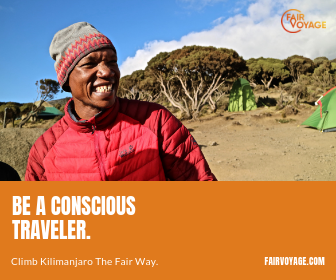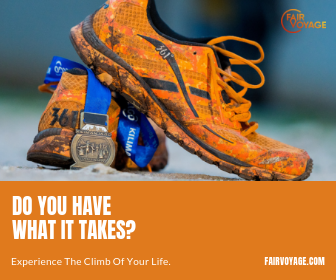Kilimanjaro Uncovered
An Alternative Path to Bliss
Author: Alexandra Tanbai (page 2 of 5)
Mount Kilimanjaro and the Tour du Mont Blanc (TMB, or Tour of Mont Blanc) are both described as some of the most memorable hikes and must do adventures for outdoors aficionados. Kilimanjaro is a climb up the tallest free-standing mountain (with fewer fair and responsible tour operators), while TMB is a trek around Western Europe’s tallest mountain. We have done both, and, indeed, they are both very scenic and memorable. However, there also are striking differences between them. If you are tossing between either or, here are 10 differences to help you decide which one might be more suitable for you:
1. Thermos – YES!!!
I strongly believe that a Thermos should be on everyone’s kit list. From hot water warming your body when it’s really cold to a steaming hot towel in the morning, I promise you will love it. It’s absolutely worth the extra weight. Read more about all its fantastic uses on Kilimanjaro here.
2. Solar charger – MAYBE
In our age of gadget addiction, solar panels have become unbelievably popular on Kilimanjaro. They are definitely worth the money if you plan to use your phone a lot, as I did to write my book! My panels worked like a charm and I absolutely loved them. However, they are a total overkill under normal circumstances. If just to take photos on your phone, you might want to invest the money into a decent camera instead. For most people, solar panels will end up in their cellars and never be used again. What a waste just for one trip!
3. Self-heating hand and toe warmers – NO!
Freezing overnight in my tent and during summit night was my biggest fear about Kilimanjaro. Of course I made sure to bring a stack of self-heating badges, i.e. air activated warmers that supposedly heat up as soon as you have opened the packaging and stay warm for several hours thereafter. I brought special hand warmers to put inside my gloves, toe warmers to stick to my socks, and even big warmers for my back. Conclusion: All of them were totally unreliable and – as a result – completely useless. The few instances they worked, they were far too hot. And when I most needed them, i.e. during summit night when I could no longer feel my fingers and toes, they didn’t work at all! I highly recommend you to invest in proper gear instead, like warm gloves and mitts, and a good pair of warming insoles.
4. Mid-layer fleece gloves – YES!

5. FUD – NO!
This is for women only. Surely you must have wondered how you will be able to pee in privacy. Blogs warn that at higher altitudes there might be nowhere to hide behind. Marketeers have jumped on this opportunity and come up with FUDs, short for Female Urination Devices. They promise the impossible: pee while standing, just like men. Theoretically, sounds great. Practically, I haven’t seen a single woman using them, nor was there any need to do so. Other than close to the summit, we always found rocks to hide behind; and even summit day won’t cause you any problems because you won’t drink much during summit night in any case. More about that here. So, ladies, no need to worry. You will be fine!
Do you have any other insights worth sharing? Or do you have any unanswered questions in order to prepare your own climb? Please leave your comments below.
There’s a lot of different kit lists floating around. When checking two or three of them, you can be reasonably certain that all essential items have been covered on one or the other. But for one key item: A Thermos. It remains a mystery to me why this marvel of functionality hasn’t yet made it onto any other Kilimanjaro kit lists; but of course I’ve included it onto the packing and checklist that I’ve compiled for you. Here’s why I would HIGHLY recommend a Thermos to EVERY Mt Kilimanjaro hiker:
1. Liquid water during summit night
All reviews I had read concurred: Your water will freeze during summit night. Yikes – what to do? The answer seemed obvious. This was my initial reason why – contrary to lack of recommendations from other sources and despite the additional weight – I decided to bring a Thermos onto Kilimanjaro. Ironically, this initial reason would prove to be the least important of all functionalities. It was all the other unexpected benefits that would make me such a staunch Thermos advocate.
Of course, it turned out to be true that all water bladders would freeze during summit night. Fortunately, I hadn’t been aware that there was a very easy workaround: Use a Nalgene bottle and carry it upside down. That way, your water will freeze from the upside-down bottom. When you drink, you simply turn it around. This little trick should leave you with a sufficient supply of liquid water throughout summit night.
Furthermore, I only realized during summit night that hydration is over-rated for your final summit push. In fact, it’s not only not necessary, but also completely impractical. Just imagine yourself wrapped in layers of pants and your hands covered by warm gloves or mittens that hopefully keep you warm in a freezing wind. Now imagine exposing your fingers to that freezing wind, pulling down all your layers that will sit tightly on top of each other, and making the effort to squat in thin air. OK, guys might have a small advantage, but it won’t be a pleasant experience for them either!
So what about necessity? Yes, drinking is imperative to stay clear of altitude sickness; but no, you don’t need to drink much during summit night. On the one hand, you simply won’t feel that thirsty when it’s freezing cold, so rest assured you won’t be suffering from thirst. On the other hand, all the prior summit successes – most of whom didn’t have much to drink – provide ample evidence that you can reach the summit safely without constantly re-hydrating during that final push. Better make sure to drink your three liters of water every day before summit night!
2. Hot water to warm your body during summit night
While drinking for hydration wasn’t such a big deal, drinking to warm up from inside was absolutely wonderful during that freezing cold summit night. Even if just for that reason, I would always carry a Thermos again to the top of Kilimanjaro.
3. Hot water to keep warm in a freezing cold tent
The same logic not only applies to summit night, but all those cold nights that you spend in your tent. Being able to drink hot water last thing before you close your eyes or first thing in the morning really helps to warm your body and feel more comfortable when stuck in a tent that at times may feel like an icebox.
4. Hot water in the morning to facilitate bowel movement
Most people will have problems with their digestive system on Kilimanjaro, especially if you are used to eating lots of fibre that you won’t get on the mountain. In order to prevent your bowels from clogging up too much, drinking hot water first thing in the morning helps a lot.
5. Hot water in the morning to wash your face
Last but not least, here’s my absolute favorite use of a Thermos: Do you know those small steaming hot towels they serve you on planes? Wouldn’t it be wonderful to have one of those served to you when you wake up in a freezing cold tent on the mountain? That’s exactly what my Thermos did for me. I just poured a tiny little bit of hot water that I kept overnight into my Thermos cup and dropped in one of those compressed single-use towels
(also highly recommendable). Then wait for a minute and let the magic unfold. Abracadabra – that tiny token will soak up the water and expand into a steaming hot towel! With this set-up, you can “wash” yourself and get fully ready for the day all within the warm comfort of your sleeping bag! Pretty cool, huh?
Now you know my secret that helped me enjoy my hiking and camping experience all the way to the top of Kilimanjaro. Please share and spread the word!
Have you noticed that most gear lists are either incomplete, or in a format that requires manually copying the contents into your own checklist? That’s the experience I’ve made, and that’s why I have prepared this comprehensive and fully editable checklist for you. It includes all the gear, accessories, toiletries, documents, medication and other items that you may want to organize and pack for Tanzania and bring onto Mt Kilimanjaro. For each item, I have also indicated my assessment whether I would personally carry them onto Kilimanjaro (again), based on my actual climbing experience.
Kilimanjaro gear list / kist list / packing list / checklistView online & print: Kilimanjaro packing list—PDF
To make it easier for you to adjust the list for your own purposes and keep track while organizing all your gear, you can download the fully editable Excel version below. The XLS file also includes further comments and explanations to help you with your own assessment.
Download & edit: Kilimanjaro packing list—XLS
I hope my Kilimanjaro gear list will help you save time with your own preparations. Do you find this useful? Or were you looking for something else? Please leave your comments below.
Complete Kilimanjaro gear list
View online & print: Kilimanjaro packing list – PDF
Download & edit: Kilimanjaro packing list – XLS
Porters are the backbone of any Kilimanjaro climb. Without them, the majority of us tourists would never be able to summit. While we like to celebrate our summit achievements, it’s really the porters who make it all possible for us and do the heavy lifting. They rush up the mountain carrying our personal stuff, tents, food, and communal equipment, all on top of their own sparse necessities. Instead of resting when they finally arrive at camp, they set up our tents, fetch water, and prepare food so that everything is ready by the time their clients arrive.
Accessories may not be as crucial as the right gear, but they will nevertheless significantly influence your comfort and perhaps even your health. Hence, being well-prepared and packing the right accessories will help you enjoy your climb and summit Mt Kilimanjaro safely.
When organizing my Kilimanjaro hike, I was obsessed by one major concern: How to keep warm feet (or rather how to avoid frostbite) during summit night? Fear turned into excitement when I learned about chili-feet from a real outdoors expert. According to him and all my further research, they are the warmest insoles currently in the market. In essence, their innovative material produces heat purely from the pressure of walking. How wonderful would that be: Just put them into your shoes and no more cold feet when walking in winter!
Millenium Camp (3,800m/12,600ft) to Mweka Gate (1,600m/5,400ft)
Distance: 14km/11mi, 5-7 hours
Altitude: 2,200m/7,200ft down in elevation
© 2025 Kilimanjaro Uncovered
Theme by Anders Noren — Up ↑











